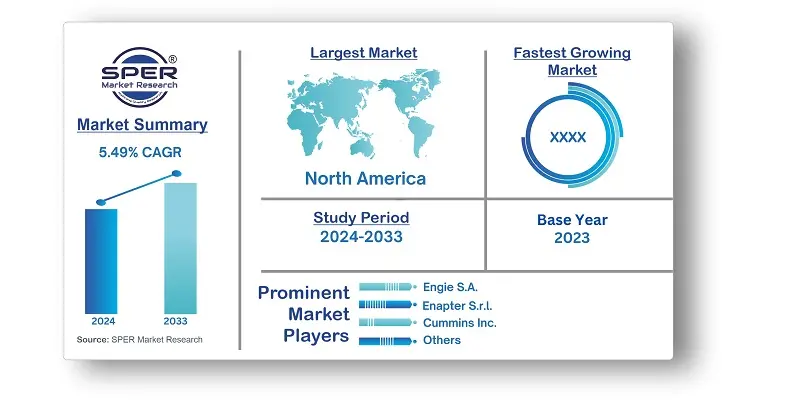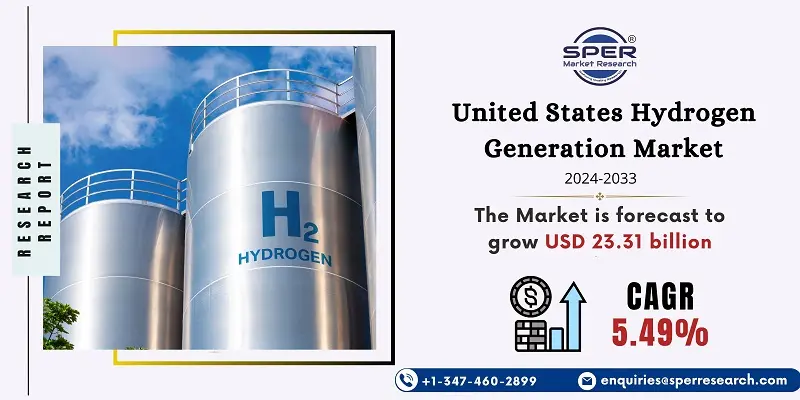
United States Hydrogen Generation Market Growth, Size, Trends, Share, Scope and Future Outlook
United States Hydrogen Generation Market Size- By Source, By Technology, By Application- Regional Outlook, Competitive Strategies and Segment Forecast to 2033
| Published: Jul-2024 | Report ID: POAE2455 | Pages: 1 - 104 | Formats*: |
| Category : Power & Energy | |||
- A 35 megawatt PEM (Proton Exchange Membrane) electrolyzer to produce green hydrogen in Niagara Falls, New York, was to be built, Linde stated in September 2022. In addition to more than doubling Linde's ability to produce green liquid hydrogen in the US, the new facility will house the largest electrolyzer the company has ever erected worldwide.
- The National Renewable Energy Laboratory (NREL) and Toyota Motor North America (Toyota) announced in August 2022 that they would be working together on a cooperative research and development agreement to construct, install, and test a one megawatt (MW) proton exchange membrane (PEM) fuel cell power generation system at the NREL's Flatirons Campus in Colorado, USA. In an integrated energy system, new study shows that hydrogen fuel cells can produce power on a huge scale.


| Report Metric | Details |
| Market size available for years | 2020-2033 |
| Base year considered | 2023 |
| Forecast period | 2024-2033 |
| Segments covered | By Source, By Technology, By Application |
| Regions covered | Eastern, Western, Southern, Northern |
| Companies Covered | Air Liquide SA, Air Products and Chemicals Inc., Cummins Inc., Enapter S.r.l., Engie S.A., Fuel Cell Energy Inc., ITM Power Plc, Linde Plc, McPhy Energy S.A., Messer Group GmbH, Taiyo Nippon Sanso Holding Corporation, and others. |
- Energy Industry Stakeholders
- Government Agencies and Policy Makers
- Investors and Financial Institutions
- Research and Development Organizations
- Technology Providers and Suppliers
- End-user Industries (e.g., Transportation, Manufacturing, Power Generation)
- Environmental and Sustainability Advocates
| By Source: |
|
| By Technology: |
|
| By Application: |
|
- United States Hydrogen Generation Market Size (FY'2024-FY'2033)
- Overview of United States Hydrogen Generation Market
- Segmentation of United States Hydrogen Generation Market By Source (Blue Hydrogen, Green Hydrogen, Grey Hydrogen)
- Segmentation of United States Hydrogen Generation Market By Technology {Steam Methane Reforming (SMR), Coal Gasification, Others}
- Segmentation of United States Hydrogen Generation Market By Application (Oil Refining, Chemical Processing, Iron & Steel Production, Others)
- Expansion Analysis of United States Hydrogen Generation Market
- Problems and Obstacles in United States Hydrogen Generation Market
- Competitive Landscape in the United States Hydrogen Generation Market
- Impact of COVID-19 and Demonetization on United States Hydrogen Generation Market
- Details on Current Investment in United States Hydrogen Generation Market
- Competitive Analysis of United States Hydrogen Generation Market
- Prominent Players in the United States Hydrogen Generation Market
- SWOT Analysis of United States Hydrogen Generation Market
- United States Hydrogen Generation Market Future Outlook and Projections (FY'2024-FY'2033)
- Recommendations from Analyst
1.1. Scope of the report1.2. Market segment analysis
2.1. Research data source
2.1.1. Secondary Data2.1.2. Primary Data2.1.3. SPER’s internal database2.1.4. Premium insight from KOL’s
2.2. Market size estimation
2.2.1. Top-down and Bottom-up approach
2.3. Data triangulation
4.1. Driver, Restraint, Opportunity and Challenges analysis
4.1.1. Drivers4.1.2. Restraints4.1.3. Opportunities4.1.4. Challenges
4.2. COVID-19 Impacts of the United States Hydrogen Generation Market
5.1. SWOT Analysis
5.1.1. Strengths5.1.2. Weaknesses5.1.3. Opportunities5.1.4. Threats
5.2. PESTEL Analysis
5.2.1. Political Landscape5.2.2. Economic Landscape5.2.3. Social Landscape5.2.4. Technological Landscape5.2.5. Environmental Landscape5.2.6. Legal Landscape
5.3. PORTER’s Five Forces
5.3.1. Bargaining power of suppliers5.3.2. Bargaining power of buyers5.3.3. Threat of Substitute5.3.4. Threat of new entrant5.3.5. Competitive rivalry
5.4. Heat Map Analysis
6.1. United States Hydrogen Generation Market Manufacturing Base Distribution, Sales Area, Product Type6.2. Mergers & Acquisitions, Partnerships, Product Launch, and Collaboration in United States Hydrogen Generation Market
7.1. United States Hydrogen Generation Market Size, Share and Forecast, By Source, 2020-20267.2. United States Hydrogen Generation Market Size, Share and Forecast, By Source, 2027-20337.3. Blue Hydrogen7.4. Green Hydrogen7.5. Grey Hydrogen
8.1. United States Hydrogen Generation Market Size, Share and Forecast, By Technology, 2020-20268.2. United States Hydrogen Generation Market Size, Share and Forecast, By Technology, 2027-20338.3. Steam Methane Reforming (SMR)8.4. Coal Gasification8.5. Others
9.1. United States Hydrogen Generation Market Size, Share and Forecast, By Application, 2020-20269.2. United States Hydrogen Generation Market Size, Share and Forecast, By Application, 2027-20339.3. Oil Refining9.4. Chemical Processing9.5. Iron & Steel Production9.6. Others
10.1. United States Hydrogen Generation Market Size and Market Share
11.1. United States Hydrogen Generation Market Size and Market Share By Region (2020-2026)11.2. United States Hydrogen Generation Market Size and Market Share By Region (2027-2033)11.3. Eastern Region11.4. Western Region11.5. Southern Region11.6. Northern Region
12.1. Air Liquide SA
12.1.1. Company details12.1.2. Financial outlook12.1.3. Product summary12.1.4. Recent developments
12.2. Air Products and Chemicals Inc.
12.2.1. Company details12.2.2. Financial outlook12.2.3. Product summary12.2.4. Recent developments
12.3. Cummins Inc.
12.3.1. Company details12.3.2. Financial outlook12.3.3. Product summary12.3.4. Recent developments
12.4. Enapter S.r.l.
12.4.1. Company details12.4.2. Financial outlook12.4.3. Product summary12.4.4. Recent developments
12.5. Engie S.A.
12.5.1. Company details12.5.2. Financial outlook12.5.3. Product summary12.5.4. Recent developments
12.6. Fuel Cell Energy Inc.
12.6.1. Company details12.6.2. Financial outlook12.6.3. Product summary12.6.4. Recent developments
12.7. ITM Power Plc
12.7.1. Company details12.7.2. Financial outlook12.7.3. Product summary12.7.4. Recent developments
12.8. Linde Plc
12.8.1. Company details12.8.2. Financial outlook12.8.3. Product summary12.8.4. Recent developments
12.9. McPhy Energy S.A.
12.9.1. Company details12.9.2. Financial outlook12.9.3. Product summary12.9.4. Recent developments
12.10. Messer Group GmbH
12.10.1. Company details12.10.2. Financial outlook12.10.3. Product summary12.10.4. Recent developments
12.11. Taiyo Nippon Sanso Holding Corporation
12.11.1. Company details12.11.2. Financial outlook12.11.3. Product summary12.11.4. Recent developments
12.12. Others
SPER Market Research’s methodology uses great emphasis on primary research to ensure that the market intelligence insights are up to date, reliable and accurate. Primary interviews are done with players involved in each phase of a supply chain to analyze the market forecasting. The secondary research method is used to help you fully understand how the future markets and the spending patterns look likes.
The report is based on in-depth qualitative and quantitative analysis of the Product Market. The quantitative analysis involves the application of various projection and sampling techniques. The qualitative analysis involves primary interviews, surveys, and vendor briefings. The data gathered as a result of these processes are validated through experts opinion. Our research methodology entails an ideal mixture of primary and secondary initiatives.



Frequently Asked Questions About This Report
PLACE AN ORDER
Year End Discount
Sample Report
Pre-Purchase Inquiry
NEED CUSTOMIZATION?
Request CustomizationCALL OR EMAIL US
100% Secure Payment






Related Reports
Our Global Clients
Our data-driven insights have influenced the strategy of 200+ reputed companies across the globe.




















